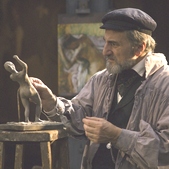SITE GUIDE
SEARCH
REVIEWS
REVIEW ARCHIVES
ADVERTISING AT CURTAINUP
FEATURES
NEWS
Etcetera and
Short Term Listings
LISTINGS
Broadway
Off-Broadway
NYC Restaurants
BOOKS and CDs
OTHER PLACES
Berkshires
London
California
New Jersey
DC
Connecticut
Philadelphia
Elsewhere
QUOTES
TKTS
PLAYWRIGHTS' ALBUMS
LETTERS TO EDITOR
FILM
LINKS
MISCELLANEOUS
Free Updates
Masthead
Writing for Us
A CurtainUp  London Review
London Review
 London Review
London ReviewThe Line
|
I've locked up my heart in a pink ballet shoe.— Degas
|

Henry Goodman as Edgar Degas (Photo: Sarah Ainslie) |
We thought back to Nicholas Wright's terrific Vincent in Brixton and Lee Hall's splendid The Pitmen Painters . But it seems that even in the hands of Henry Goodman, Edgar Degas was a dry old stick and there's a limit to the number of times one play can feature a scene where Degas expresses annoyance at his wilder pupil Suzanne Valadon.
It's all the more of a shame because the out of the way, off the theatrically beaten track except for those in the know, carbon neutral Arcola Theatre is such a worthy cause, bringing many innovative productions and fresh theatre to the East End. I like the space and the accueil, the old rag trade factory with its wide playing area, the audience on all four sides; but on this occasion, the easel placed at one end could only be seen by half the audience so while the painting was discussed by Suzanne and Degas, many were totally unable to see it. Ok a duplicate painting displayed at the other end might have been confusing but after the joy of watching the Ashington Group paintings viewed and discussed in The Pitman Painters it felt like half the audience were listening to a radio play and we know how well that works when discussing the visual arts!
I liked the gauze hanging canvases printed with paintings of the period but would have liked to see Degas working on his famous petite danseuse sculpture rather than a tiny maquette but I suspect that the famous sculpture was completed long before the setting of the play. The studio is stuffed with oils and brushes and easels and at one point Degas teaches Suzanne to make an etching using copper plates. The bare floorboards have patches coloured by oil pastels. Suzanne's later costumes after she has become a wealthy woman are interesting and extravagant
Timberlake Wertenbaker's play might have worked better as a film script where the director could have inserted beautiful scenes of Montmartre and the paintings of Suzanne's lovers Renoir and Lautrec whom she also modelled for. I indeed longed for cameo performances of these famous painters. Suzanne offers to model for Degas, exactly reproducing the long naked back of the woman in the drawing he is working on but Degas tells her to leave because he views her as his pupil not the lower class of model. Despite the many references to French history, politics and painting, The Line is a dry, wordy affair where the actors work very hard.
Selina Cadell is Zoë, Degas' stiff and unsmiling housekeeper and almost protector placing herself between Degas and any visitors. Sarah Smart as Suzanna is animated, resilient and pretty and for me the most interesting character in the play. Degas is very opinionated. He says "I can tell Beethoven was deaf" or condemns Zola's defence of Dreyfus. Wagner comes off badly too! Henry Goodman twinkles too little in this portrayal of a rather sad, conventional man whose art seems as much the product of hard work and application as inspiration. Sadly The Line is also rather hard work whereas one had hoped it would be inspirational.
The play ends on a depressing note as Degas tells us that "Old age is nothing more than the loss of joy" and the prophetic, "Soon there will be no art — only commerce!"
|
Subscribe to our FREE email updates with a note from editor Elyse Sommer about additions to the website -- with main page hot links to the latest features posted at our numerous locations. To subscribe,
E-mail: esommer@curtainup.comesommer@curtainup.com
put SUBSCRIBE CURTAINUP EMAIL UPDATE in the subject line and your full name and email address in the body of the message -- if you can spare a minute, tell us how you came to CurtainUp and from what part of the country. |
| The Line
Written by Timberlake Wertenbaker Directed by Matthew Lloyd Starring: Henry Goodman, Selina Cadell, Sarah Smart Design: William Dudley Lighting: Oliver Fenwick Sound: Steve Mayo Running time: Two hours 20 minutes with one interval Box Office: 020 7503 1646 Booking to 12th December 2009 Reviewed by Lizzie Loveridge based on 23rd November 2009 performance at the Arcola Theatre, Arcola Street, London E8 2DJ (Rail: Dalston) |
|
REVIEW FEEDBACK Highlight one of the responses below and click "copy" or"CTRL+C"
Paste the highlighted text into the subject line (CTRL+ V): Feel free to add detailed comments in the body of the email . . . also the names and emails of any friends to whom you'd like us to forward a copy of this review. You can also contact us at Curtainup at Facebook . . . Curtainup at Twitter. . . and at our Blog Annex |
|
London Theatre Tickets Lion King Tickets Billy Elliot Tickets Mighty Boosh Tickets Mamma Mia Tickets We Will Rock You Tickets Theatre Tickets |




